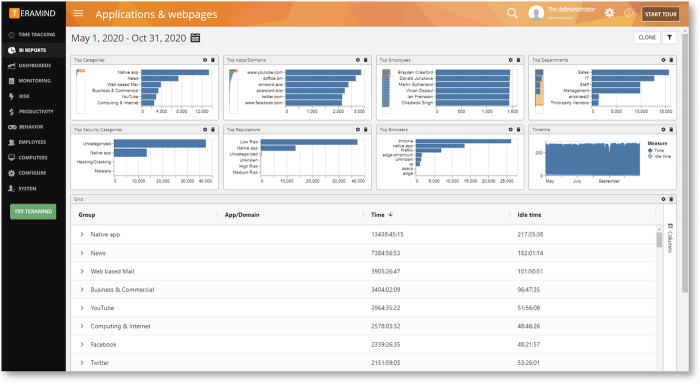Top ethical employee monitoring software sets the stage for this enthralling narrative, offering readers a glimpse into a story that is rich in detail and brimming with originality. As organizations navigate the complex landscape of employee monitoring, ethical considerations play a pivotal role in shaping the tools they choose to implement.
Detailing the key features, implementation strategies, and compliance measures of ethical monitoring software provides a comprehensive understanding of its importance in the modern workplace.
Importance of Ethical Employee Monitoring Software
When it comes to choosing monitoring software for employees, ethical considerations play a crucial role in ensuring fair treatment and respecting privacy rights.
Unethical monitoring practices can lead to a breach of trust between employers and employees, resulting in a negative work environment and potential legal issues.
Potential Risks of Unethical Monitoring Practices
- Violation of privacy rights and data protection laws.
- Damage to employee morale and trust.
- Increased risk of employee burnout and stress.
- Potential legal consequences and lawsuits.
Benefits of Using Ethical Monitoring Software
- Establishing transparency and trust between employers and employees.
- Promoting a positive work culture based on mutual respect.
- Improving productivity and efficiency through fair monitoring practices.
- Protecting sensitive employee data and maintaining compliance with regulations.
Features of Top Ethical Employee Monitoring Software

Employee monitoring software plays a crucial role in ensuring productivity and security in the workplace. However, ethical considerations are paramount when implementing such tools to protect employee privacy and maintain trust within the organization. Here are key features that distinguish ethical monitoring software from traditional tools:
Data Encryption and Secure Storage
Ethical monitoring software prioritizes data security by encrypting all employee data and ensuring secure storage to prevent unauthorized access. This feature helps in safeguarding sensitive information and maintaining confidentiality.
Transparency and Consent
One of the main features of ethical monitoring software is transparency. Employees are informed about the monitoring activities, the type of data collected, and the purposes it serves. Additionally, employees are required to give their consent before any monitoring takes place, ensuring their participation is voluntary.
Anonymization of Data
Ethical monitoring software anonymizes employee data to protect individual identities and ensure that the focus remains on behavior patterns rather than personal details. This helps in maintaining privacy while still achieving the desired insights for improving productivity.
Customizable Monitoring Parameters
Ethical software allows organizations to set customizable monitoring parameters based on specific needs and requirements. This flexibility ensures that monitoring is tailored to the organization's goals without compromising employee privacy.
Behavior-based Analysis
Ethical monitoring software focuses on behavior-based analysis rather than individual performance metrics. By analyzing patterns and trends in behavior, organizations can identify areas for improvement without invading employees' personal space.
Real-time Alerts and Notifications
Ethical monitoring software includes real-time alerts and notifications to address any potential issues promptly. This feature helps in proactive management and intervention, ensuring a supportive and productive work environment.
Audit Trails and Compliance
Ethical software maintains detailed audit trails of monitoring activities to ensure compliance with regulations and ethical standards. This transparency helps in building trust between employers and employees while demonstrating a commitment to ethical practices.Overall, ethical employee monitoring software prioritizes transparency, data security, and employee consent to uphold ethical standards while still achieving organizational goals.
Implementation and Integration of Ethical Employee Monitoring Software
When it comes to implementing ethical employee monitoring software in a workplace, there are several best practices that organizations should follow to ensure successful deployment and adoption. However, organizations may also face challenges during the integration of ethical monitoring tools.
Let's explore some strategies for a smooth implementation process.
Best Practices for Implementing Ethical Monitoring Software
- Clearly communicate the purpose and benefits of the monitoring software to employees to gain their trust and cooperation.
- Ensure transparency by establishing clear policies and guidelines regarding the use of the monitoring software.
- Provide training to employees on how the software works and what data is being collected to address any concerns or misconceptions.
- Respect employee privacy by only monitoring relevant work-related activities and avoiding invasive surveillance.
Challenges Organizations May Face
- Resistance from employees who may feel their privacy is being invaded, leading to decreased morale and productivity.
- Compliance with data protection laws and regulations to safeguard employee data and prevent legal issues.
- Integration with existing systems and processes within the organization, which may require additional resources and time.
Strategies for Successful Deployment
- Involve key stakeholders in the decision-making process to ensure buy-in and support for the implementation of the monitoring software.
- Conduct a pilot program to test the software in a controlled environment before full deployment to identify and address any issues or concerns.
- Collect feedback from employees throughout the implementation process and make adjustments as needed to improve acceptance and effectiveness.
- Maintain open communication channels to address any questions or concerns that may arise among employees regarding the monitoring software.
Ensuring Compliance with Ethical Standards

When monitoring employees, it is crucial for organizations to ensure compliance with legal and ethical standards to protect employee privacy and rights while maintaining a productive work environment.
Regulatory Requirements for Monitoring Software
Organizations need to consider various regulatory requirements when implementing monitoring software to ensure they are in compliance with the law:
- Ensure transparency: Clearly communicate to employees about the monitoring practices in place.
- Respect employee privacy: Avoid monitoring personal activities and only focus on work-related tasks.
- Comply with data protection laws: Safeguard employee data and ensure it is not misused or shared without consent.
- Adhere to labor laws: Ensure that monitoring practices do not violate labor laws related to privacy and employee rights.
Tips for Ethical and Legal Compliance
Here are some tips for organizations to ensure they are ethically and legally compliant with their monitoring practices:
- Establish clear monitoring policies: Develop comprehensive policies outlining the purpose, scope, and limitations of monitoring.
- Obtain employee consent: Seek consent from employees before implementing monitoring software and provide them with information on what is being monitored.
- Train employees: Provide training on the use of monitoring software and educate employees on their rights and responsibilities.
- Regularly review and update policies: Stay informed about changes in laws and regulations related to monitoring and update policies accordingly.
Epilogue
In conclusion, the realm of ethical employee monitoring software offers a nuanced approach to balancing organizational needs with employee rights. By prioritizing ethical considerations, companies can foster a culture of trust and transparency while optimizing performance and productivity.
Question Bank
What are the key benefits of using ethical employee monitoring software?
Ethical monitoring software promotes transparency, employee trust, and data security while ensuring compliance with legal standards.
How does ethical software protect employee privacy compared to traditional monitoring tools?
Ethical software employs anonymization techniques and data encryption to safeguard employee privacy more effectively.
What are the best practices for successfully implementing ethical monitoring software?
Effective communication, clear policies, and employee training are essential for seamless integration of ethical monitoring tools.






![What is IT Project Management? [2023] • Asana](https://business.mardinata.com/wp-content/uploads/2025/10/project-management-industries-120x86.jpg)




